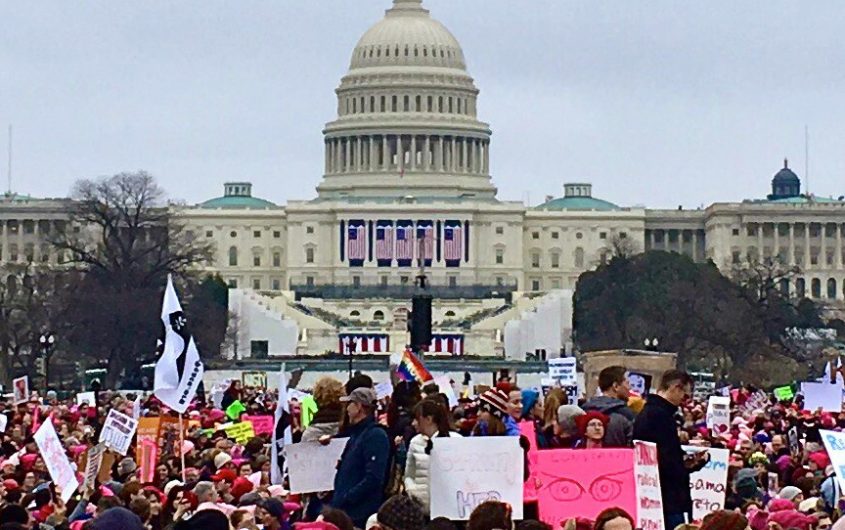
Photo by author
Standing United: The Women’s March on Washington
President Donald Trump’s sexist remarks made during the 2016 campaign, such as calling a former Miss Universe winner “Miss Piggy” or alluding to a female reporter’s menstrual cycle, have caused him to lose favor with many members of the opposite sex. However, the Women’s March that took place on his first day in office was not limited to female protesters opposing misogyny. Hundreds of thousands of Americans of all genders, races, orientations, and beliefs flooded into the capital on Saturday, many wearing pink knitted hats, to demonstrate against the new White House resident and the policies he stands for. According to The New York Times, an estimated half-million people, about three times as many as attended the inauguration, went to the march. Participants traveled from all corners of the country, from California to Maine, and patiently waited for overcrowded Metro trains to take them to the National Mall where protesters marched peacefully, as they did during the Civil Rights and Vietnam War protests of the 1960s and 1970s.
Marchers also took to the streets across the U.S. and around the world, including large turnouts in German cities. There were several registered “sister” marches in Germany, including cities such as Munich, Düsseldorf, Bonn, Frankfurt, and Berlin. Frankfurt had the largest German sister march with an estimated 2,100 participants. The country’s second largest march occurred in Berlin in front of the Brandenburg Gate and U.S. Embassy, with a turnout of around 1,000 people. Much like the March on Washington, protesters in the German capital demonstrated with an array of cleverly crafted posters, such as “Mr. Trump, you are no Berliner.” Marchers included not only Germans, but also people from all over the world, with reasons for protesting spanning from women’s rights to climate protection. Even though these sister marches were organized in solidarity with the March on Washington, many participants used this platform to express their discontent with the new president of the U.S. and to demonstrate their fear that Trump’s ascent to power might strengthen other right-wing populist EU politicians. With elections just around the corner in major EU countries, such as France and Germany, this political trend has become a significant concern for many EU citizens and the future of the EU as a whole. While the uncertain future of the EU may have been one of the contributing factors for the large German protester turnout, it was not limited only to that.
Although individuals, both nationally and internationally, had their own reasons for demonstrating, one recurring theme was abundantly clear: fear of losing basic rights. The sea of posters included uteri sketches, crumbling wall images, illustrations of Trump as Putin’s puppet, witty wordplay, and much, much more. What began as a Facebook event exploded into a massive, all-encompassing movement advocating civil rights, regardless of sex, race, sexual preference, or nationality—and it took place, remarkably, without significant vandalism or violence. The Women’s March displayed democracy at its finest because it gave thousands of people a platform to express their worries, discontent, and outrage surrounded by a diverse yet like-minded army of peaceful marchers. Even though the election results left many feeling angry and helpless, the mood of the march was peaceful and empowering. Recent elections have demonstrated how deeply divided the U.S. is on a socio-political level and how important it is to find consensus. Achieving unity within the country will be a recurring theme over the next four years. While it is unclear what the new administration will do next, the Women’s March has left many feeling hopeful and mobilized. Overall, the phenomenon of millions of people coming together peacefully, advocating not only their own rights but those of their fellow man, has set a hopeful symbol of international unity for years to come.








